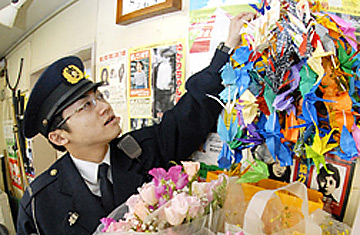
Flowers and paper cranes are placed on the police box, or koban, where Sergeant Kunihiko Miyamoto worked, Itabashi, Tokyo, Japan.
That February evening, however, Miyamoto was called upon to do something extraordinary. As he helped unlock the bicycle, a passerby rushed into his one-man koban to tell him that a woman was standing on the nearby train tracks. Miyamoto jogged over to the tracks and escorted the woman back to his police box, as she pulled against him and screamed that she wanted to die. When they made it back to the koban, the woman broke free and ran toward the rail crossing. With a train less than a quarter-mile away, Miyamoto leapt onto the tracks and tried to pull the suicidal woman into an emergency safety area beneath the platform. She wouldn't move. Miyamoto waved at the incoming train repeatedly, but it was an express traveling at nearly 40 mph — he never had a chance. Though he managed to protect the woman, who survived with a broken pelvis, Miyamoto was struck full by the train. He suffered a broken skull and would linger in a coma for nearly a week before dying on Feb. 12, leaving behind a wife and a 20-year-old son.
Miyamoto's death was mourned and his sacrifice celebrated in tiny Tokiwadai and throughout Tokyo. His koban was stuffed with flowers and cards from well wishers, and his colleagues lost track of the number of people who signed Miyamoto's condolence book. While Miyamoto was still in the hospital, students at a nearby elementary school delivered hundreds of folded cranes, a traditional get-well gift. "He was a stout man with caring eyes," remembers a tearful 73-year-old Yoshie Ikeda. "He always called out to me, saying 'Take care!'" Prime Minister Shinzo Abe visited Miyamoto's police station on the night of Feb. 12 to attend a viewing of the officer's body and pay his respects to Miyamoto's family. He told reporters afterward, "I'm proud of Mr. Miyamoto, who tried to save someone's life, both as the premier and as a Japanese."
The circumstances of the accident were far too common in Tokyo. According to the National Police Agency, 795 people committed suicide on the railways system in fiscal 2005 — more than two per day. Suicides occur with such frequency that affected trains rarely stop for more than an hour or two. There aren't enough Miyamotos out there.
The people who live and work around Tokiwadai will have to get by without Miyamoto looking out for them — and as the city closes down the kobans, omawari like him will become a vanishing breed in Tokyo. The government needs to cut its budget, but it will be a shame if cops like Miyamoto are lost in the process. "Police officers are always in uniform so there's usually some distance from us," says Kawano the grocer. "But he wasn't like that. He was more like a pal." He was also a hero. Reported by Yuki Oda/Tokyo
